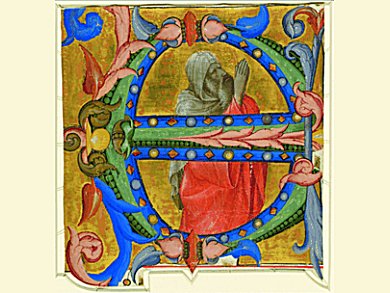John K. Delaney, National Gallery of Art, Washington, D.C., USA, and colleagues report on the use of a novel hyperspectral near infrared (NIR) imaging spectrometer (1000–2500 nm, 4000–10000 cm–1) having higher spectral resolution, light sensitivity, and spatial coverage than other instruments making it possible to identify and map CH, methylenic and amide groups associated with organic binders, likely egg yolk, in paint layers only tens of mm thick, at the low light levels required for the analysis of works of art on paper and parchment. This instrument, and an experimental procedure previously developed for paintings, were used for the study of an early 15th century illuminated manuscript leaf on parchment painted by Lorenzo Monaco and representing a Praying Prophet within a decorated initial E on a gilded background (pictured).
Art historians and conservationists need detailed information about materials used by artists, such as the pigments and the organic binding agents, for example gum Arabic or egg white, which were used to carry the pigment. Illuminated manuscripts are rarely if ever sampled due to the small dimensions of the illuminations and their fragility and because there is no prospect of being able to take paint micro-samples, emphasizing the need for in situ methods.
This technique will be very important for defining the history of technology of illuminated manuscripts and anything else of that kind.
- Near Infrared Reflectance Imaging Spectroscopy to Map Paint Binders In Situ on Illuminated Manuscripts,
Paola Ricciardi, John K. Delaney, Michelle Facini, Jason G. Zeibel, Marcello Picollo, Suzanne Lomax, Murray Loew,
Angew. Chem. Int. Ed. 2012.
DOI: 10.1002/anie.201200840




